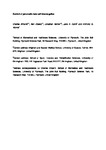Control of pancreatic β-cell bioenergetics.
| dc.contributor.author | Affourtit, Charles | |
| dc.contributor.author | Alberts, B | |
| dc.contributor.author | Barlow, J | |
| dc.contributor.author | Carré, JE | |
| dc.contributor.author | Wynne, AG | |
| dc.date.accessioned | 2018-04-26T14:35:06Z | |
| dc.date.issued | 2018-06 | |
| dc.identifier.issn | 0300-5127 | |
| dc.identifier.issn | 1470-8752 | |
| dc.identifier.uri | http://hdl.handle.net/10026.1/11355 | |
| dc.description.abstract |
The canonical model of glucose-stimulated insulin secretion (GSIS) by pancreatic β-cells predicts a glucose-induced rise in the cytosolic ATP/ADP ratio. Such bioenergetic sensitivity to metabolic fuel is unusual as it implies that ATP flux is governed, to a significant extent, by ATP supply, while it is predominantly demand-driven in other cell types. Metabolic control is generally shared between different processes, but potential control of ATP consumption over β-cell bioenergetics has been largely ignored to date. The present paper offers a brief overview of experimental evidence that demonstrates ATP flux control by glucose-fuelled oxidative phosphorylation. Based on old and new data, it is argued that ATP supply does not hold exclusive control over ATP flux, but shares it with ATP demand, and that the distribution of control is flexible. Quantification of the bioenergetic control distribution will be important from basic and clinical perspectives, but precise measurement of the cytosolic ATP/ADP ratio is complicated by adenine nucleotide compartmentalisation. Metabolic control analysis of β-cell bioenergetics will likely clarify the mechanisms by which glucose and fatty acids amplify and potentiate GSIS, respectively. Moreover, such analysis may offer hints as to how ATP flux control shifts from ATP supply to ATP demand during the development of type 2 diabetes, and why prolonged sulfonylurea treatment causes β-cell deterioration. | |
| dc.format.extent | 555-564 | |
| dc.format.medium | Print-Electronic | |
| dc.language | en | |
| dc.language.iso | en | |
| dc.publisher | Portland Press | |
| dc.subject | bioenergetics | |
| dc.subject | insulin secretion | |
| dc.subject | metabolic control analysis | |
| dc.subject | mitochondrial respiration | |
| dc.subject | oxidative phosphorylation | |
| dc.subject | pancreatic β-cell | |
| dc.title | Control of pancreatic β-cell bioenergetics. | |
| dc.type | journal-article | |
| dc.type | Journal Article | |
| dc.type | Research Support, Non-U.S. Gov't | |
| dc.type | Review | |
| plymouth.author-url | https://www.ncbi.nlm.nih.gov/pubmed/29666215 | |
| plymouth.issue | 3 | |
| plymouth.volume | 46 | |
| plymouth.publication-status | Published | |
| plymouth.journal | Biochemical Society Transactions | |
| dc.identifier.doi | 10.1042/BST20170505 | |
| plymouth.organisational-group | /Plymouth | |
| plymouth.organisational-group | /Plymouth/Faculty of Health | |
| plymouth.organisational-group | /Plymouth/Faculty of Health/School of Biomedical Sciences | |
| plymouth.organisational-group | /Plymouth/REF 2021 Researchers by UoA | |
| plymouth.organisational-group | /Plymouth/REF 2021 Researchers by UoA/UoA01 Clinical Medicine | |
| plymouth.organisational-group | /Plymouth/Research Groups | |
| plymouth.organisational-group | /Plymouth/Research Groups/Institute of Translational and Stratified Medicine (ITSMED) | |
| plymouth.organisational-group | /Plymouth/Research Groups/Institute of Translational and Stratified Medicine (ITSMED)/CBR | |
| plymouth.organisational-group | /Plymouth/Users by role | |
| plymouth.organisational-group | /Plymouth/Users by role/Academics | |
| plymouth.organisational-group | /Plymouth/Users by role/Researchers in ResearchFish submission | |
| dc.publisher.place | England | |
| dcterms.dateAccepted | 2018-03-08 | |
| dc.rights.embargodate | 2019-4-17 | |
| dc.identifier.eissn | 1470-8752 | |
| dc.rights.embargoperiod | Not known | |
| rioxxterms.versionofrecord | 10.1042/BST20170505 | |
| rioxxterms.licenseref.uri | http://www.rioxx.net/licenses/all-rights-reserved | |
| rioxxterms.licenseref.startdate | 2018-06 | |
| rioxxterms.type | Journal Article/Review | |
| plymouth.funder | Why do pancreatic beta cells waste energy?::MRC |


